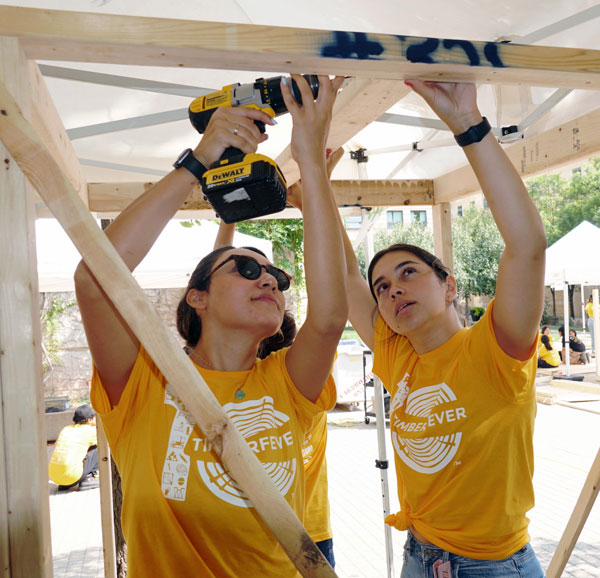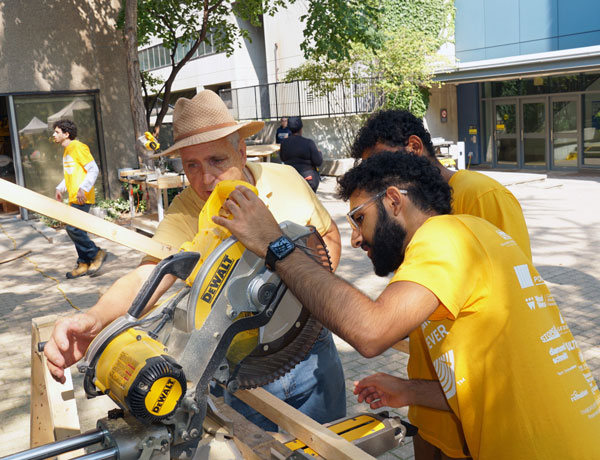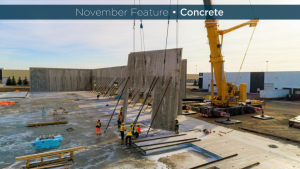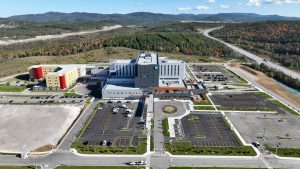Participants in TimberFever, the annual design-build competition for university engineering and architectural students across Canada, picked up tools on a warm weekend at the campus of Toronto Metropolitan University (TMU) to build features that accent transitional cabin communities for the homeless.
“Homelessness has become a pressing issue in Toronto over the last few years so we wanted to highlight the urgent need for innovative housing solutions,” says Khushi Gandhi, the architectural chair of the event and a fourth-year student at TMU.
To celebrate TimberFever’s 10th anniversary, each team, comprised of an equal number of engineering and architectural students, designed a feature taken from previous TimberFever design briefs that could enhance a homeless cabin community, she says.
David Moses, principal at Moses Structural Engineers, the Toronto-based engineering firm and organizer of the annual event, partnered with Two Steps Home, a non-profit corporation that provides modular, transitional and low-capital/high speed cabin communities for the homeless in Toronto.

The organization is comprised of volunteer architects, engineers, carpenters, some of whom were on hand to assist the close to 100 participants on their projects. The students came from 10 Canadian universities in Ontario, Quebec and Alberta for the three-day event.
The participants referenced drawings from homeless cabin communities created by Two Steps Home.
“We’re lucky to have them as a consultant to make this theme realistic…give it real-life implications,” says Israel Castro, civil engineering chair for this year’s event.
“While we’re not tackling a solution, we are trying to enhance their solution and help bring the issue of homelessness forward.”
The projects had to fit within prescriptive dimensions of the design briefs but from there participants were allowed creative freedom to express their design ideas.
“We didn’t want to box in designs,” Castro says, emphasizing “enhancing” cabin communities was paramount to the experience for the students. “They really had to think critically about it.”
Gandhi and Castro have both been involved over the past four years in TimberFever, starting out as participants in earlier editions of the annual event.

Collaboration between architectural and engineering students to build projects out of wood has been at the foundation of the exercise since its inception a decade ago.
The use of wood in construction has been “a big driver” for Castro and many others participating in the event.
Gandhi adds the experience “pushes” architectural students to work with lumber, a material that many might otherwise have little experience within their academic programs.
The students, many of whom had little to no experience with building tools, were instructed in proper and safe use of power tools by members of Carpenters’ Local 27. The carpenters also guided them through the challenges of constructing their projects.
“On paper your design might look good, but carpenters can help you bring it to reality,” says Castro.
“I remember when I was in the competition (a few years ago) I was struggling with some of my joints and angles and the carpenters, almost like magic, explained the tools and how to make the cuts.
“It has been really cool to see the different ways we each approach design. It has helped me understand how important design and collaboration within multi-disciplinary teams can be.”











Recent Comments
comments for this post are closed